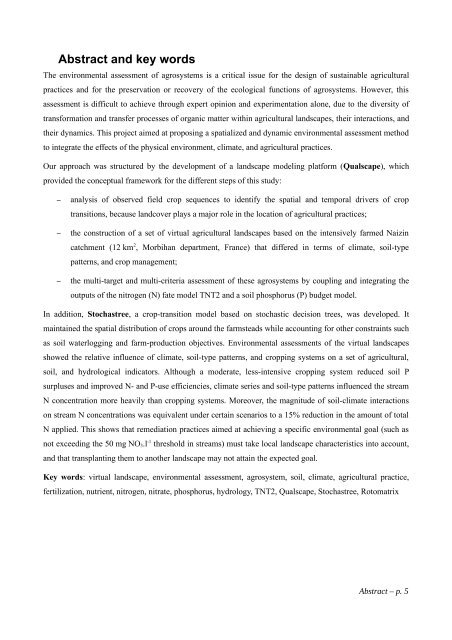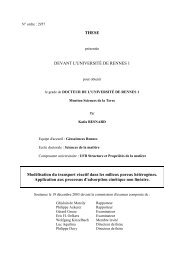Paysages virtuels et analyse de scénarios pour évaluer les impacts ...
Paysages virtuels et analyse de scénarios pour évaluer les impacts ...
Paysages virtuels et analyse de scénarios pour évaluer les impacts ...
Create successful ePaper yourself
Turn your PDF publications into a flip-book with our unique Google optimized e-Paper software.
Abstract and key words<br />
The environmental assessment of agrosystems is a critical issue for the <strong>de</strong>sign of sustainable agricultural<br />
practices and for the preservation or recovery of the ecological functions of agrosystems. However, this<br />
assessment is difficult to achieve through expert opinion and experimentation alone, due to the diversity of<br />
transformation and transfer processes of organic matter within agricultural landscapes, their interactions, and<br />
their dynamics. This project aimed at proposing a spatialized and dynamic environmental assessment m<strong>et</strong>hod<br />
to integrate the effects of the physical environment, climate, and agricultural practices.<br />
Our approach was structured by the <strong>de</strong>velopment of a landscape mo<strong>de</strong>ling platform (Qualscape), which<br />
provi<strong>de</strong>d the conceptual framework for the different steps of this study:<br />
– analysis of observed field crop sequences to i<strong>de</strong>ntify the spatial and temporal drivers of crop<br />
transitions, because landcover plays a major role in the location of agricultural practices;<br />
– the construction of a s<strong>et</strong> of virtual agricultural landscapes based on the intensively farmed Naizin<br />
catchment (12 km 2 , Morbihan <strong>de</strong>partment, France) that differed in terms of climate, soil-type<br />
patterns, and crop management;<br />
– the multi-targ<strong>et</strong> and multi-criteria assessment of these agrosystems by coupling and integrating the<br />
outputs of the nitrogen (N) fate mo<strong>de</strong>l TNT2 and a soil phosphorus (P) budg<strong>et</strong> mo<strong>de</strong>l.<br />
In addition, Stochastree, a crop-transition mo<strong>de</strong>l based on stochastic <strong>de</strong>cision trees, was <strong>de</strong>veloped. It<br />
maintained the spatial distribution of crops around the farmsteads while accounting for other constraints such<br />
as soil waterlogging and farm-production objectives. Environmental assessments of the virtual landscapes<br />
showed the relative influence of climate, soil-type patterns, and cropping systems on a s<strong>et</strong> of agricultural,<br />
soil, and hydrological indicators. Although a mo<strong>de</strong>rate, <strong>les</strong>s-intensive cropping system reduced soil P<br />
surpluses and improved N- and P-use efficiencies, climate series and soil-type patterns influenced the stream<br />
N concentration more heavily than cropping systems. Moreover, the magnitu<strong>de</strong> of soil-climate interactions<br />
on stream N concentrations was equivalent un<strong>de</strong>r certain scenarios to a 15% reduction in the amount of total<br />
N applied. This shows that remediation practices aimed at achieving a specific environmental goal (such as<br />
not exceeding the 50 mg NO3.l -1 threshold in streams) must take local landscape characteristics into account,<br />
and that transplanting them to another landscape may not attain the expected goal.<br />
Key words: virtual landscape, environmental assessment, agrosystem, soil, climate, agricultural practice,<br />
fertilization, nutrient, nitrogen, nitrate, phosphorus, hydrology, TNT2, Qualscape, Stochastree, Rotomatrix<br />
Abstract – p. 5



